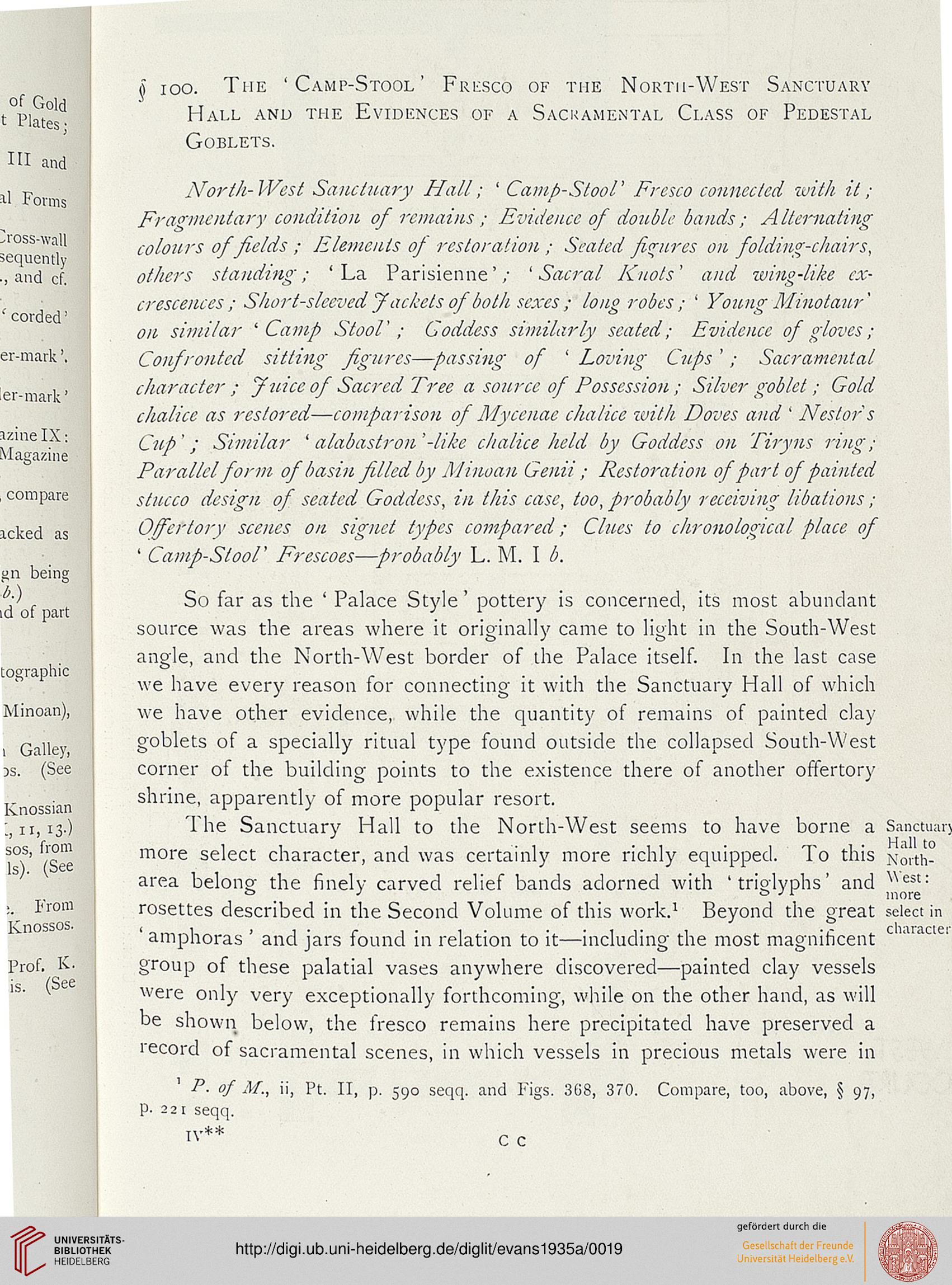() ioo. The 'Camp-Stool' Fresco of the North-West Sanctuary
Hall and the Evidences of a Sacramental Class of Pedestal
Goblets.
North- West Sanctuary Hall; ' Camp-Stool' Fresco connected with it ;
Fragmentary condition of remains ; Evidence of double bands; Alternating
colours of fields ; Elements of restoration ; Seated figures on folding-chairs,
others standing; 'La Parisienne'; 'Sacral Knots' and wing-like ex-
crescences; Short-sleeved Jackets ofboth sexes ; long robes ; ' Young Minotaur'
on similar 'Camp Stool' ; Coddess similarly seated; Evidence of gloves ;
Confronted silting figures—passing of ' Loving Cups '; Sacramental
character ; Juice of Sacred Tree a source of Possession ; Silver goblet; Gold
chalice as restored—comparison of Mycenae chalice with Doves and ' Nestor's
Cup'; Similar ' alabastron'-like chalice held by Goddess on Tiryns ring;
Parallel form of'basin filled by Minoau Genii ; Restoration of part of painted
stucco design of seated Goddess, in this case, loo, probably receiving libations ;
Offertory scenes on signet types compared; Clues to chronological place of
' Camp-Slool' Frescoes—probably L. M. I /;.
So far as the ' Palace Style' pottery is concerned, its most abundant
source was the areas where it originally came to light in the South-West
angle, and the North-West border of the Palace itself. In the last case
we have every reason for connecting it with the Sanctuary Hall of which
we have other evidence, while the quantity of remains of painted clay
goblets of a specially ritual type found outside the collapsed South-West
corner of the building points to the existence there of another offertory
shrine, apparently of more popular resort.
The Sanctuary Hall to the North-West seems to have borne a
more select character, and was certainly more richly equipped. To this
area belong the finely carved relief bands adorned with ' triglyphs' and
rosettes described in the Second Volume of this work.1 Beyond the great
' amphoras ' and jars found in relation to it—including the most magnificent
group of these palatial vases anywhere discovered—painted clay vessels
were only very exceptionally forthcoming, while on the other hand, as will
be shown below, the fresco remains here precipitated have preserved a
record of sacramental scenes, in which vessels in precious metals were in
ii, Pt. II, p. 590 seqq. and Figs. 3GS, 370. Compare, too, above, § 97,
Sanctuarj
Hall to
North-
\Yest:
more
select in
character
' P. of M.,
!i seqq.
IV
.**
Hall and the Evidences of a Sacramental Class of Pedestal
Goblets.
North- West Sanctuary Hall; ' Camp-Stool' Fresco connected with it ;
Fragmentary condition of remains ; Evidence of double bands; Alternating
colours of fields ; Elements of restoration ; Seated figures on folding-chairs,
others standing; 'La Parisienne'; 'Sacral Knots' and wing-like ex-
crescences; Short-sleeved Jackets ofboth sexes ; long robes ; ' Young Minotaur'
on similar 'Camp Stool' ; Coddess similarly seated; Evidence of gloves ;
Confronted silting figures—passing of ' Loving Cups '; Sacramental
character ; Juice of Sacred Tree a source of Possession ; Silver goblet; Gold
chalice as restored—comparison of Mycenae chalice with Doves and ' Nestor's
Cup'; Similar ' alabastron'-like chalice held by Goddess on Tiryns ring;
Parallel form of'basin filled by Minoau Genii ; Restoration of part of painted
stucco design of seated Goddess, in this case, loo, probably receiving libations ;
Offertory scenes on signet types compared; Clues to chronological place of
' Camp-Slool' Frescoes—probably L. M. I /;.
So far as the ' Palace Style' pottery is concerned, its most abundant
source was the areas where it originally came to light in the South-West
angle, and the North-West border of the Palace itself. In the last case
we have every reason for connecting it with the Sanctuary Hall of which
we have other evidence, while the quantity of remains of painted clay
goblets of a specially ritual type found outside the collapsed South-West
corner of the building points to the existence there of another offertory
shrine, apparently of more popular resort.
The Sanctuary Hall to the North-West seems to have borne a
more select character, and was certainly more richly equipped. To this
area belong the finely carved relief bands adorned with ' triglyphs' and
rosettes described in the Second Volume of this work.1 Beyond the great
' amphoras ' and jars found in relation to it—including the most magnificent
group of these palatial vases anywhere discovered—painted clay vessels
were only very exceptionally forthcoming, while on the other hand, as will
be shown below, the fresco remains here precipitated have preserved a
record of sacramental scenes, in which vessels in precious metals were in
ii, Pt. II, p. 590 seqq. and Figs. 3GS, 370. Compare, too, above, § 97,
Sanctuarj
Hall to
North-
\Yest:
more
select in
character
' P. of M.,
!i seqq.
IV
.**





